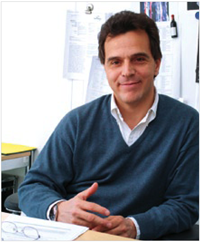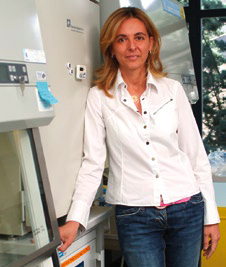on March 17, 2007

Fabio Grassi
The immune system preserves organism integrity by detecting potential pathogenic modifications in the different tissues and eliminating cells harboring such modifications. T lymphocytes play a crucial role in orchestrating the immune response. Expression of the pre-T cell receptor (pre-TCR) in the plasma membrane of immature T cell in the thymus determines cell proliferation and differentiation of T lymphocytes.After completion of the differentiation program,T cells migrate outside the thymus to colonize peripheral lymphoid organs, such as lymph nodes, spleen and Peyer’s patches in the gut, where immune responses originate.A peculiarity that distinguishes the pre-TCR from most receptors expressed in the cell membrane is the transduction of an activating signal to the cell interior independently of interaction with a ligand.This characteristic is typical of mutated receptors, which are responsible of neoplastic transformation, i.e. tumors.
Our experiments are aimed at understanding the mechanisms leading to this property of the pre-TCR. Since pre-TCR signaling is characterized by translocation of the associated CD3 signaling modules in particular membrane microdomains, defined as “rafts”, and thereafter to endosomes inside the cell, we are selectively shuttling the CD3 modules to these cellular compartments in pre-TCR negative immature T cells.
The study of the effects of the selective CD3 translocation should allow us to elucidate the role played by rafts and endosomes for the distinct functions of the pre-TCR.
Another important issue connected to pre-TCR biology is the oncogenic potential of such receptor once aberrantly expressed after T cell differentiation. Indeed, pre-TCR expression is detected in a large variety of human acute T lymphoblastic leukemias (T-ALL).Therefore, the characterization of pre-TCR signaling will have possible implications in the pathogenesis of leukemia and lymphoma as well as regulation of T cell activation.

Markus Manz
Dendritic cells (DCs) are a heterogeneous immune system cell population, originally defined by their ability to most efficiently present antigens to T cells.
For simplicity, we here divide DCs in two major subsets, conventional DCs (cDCs, i.e. classical tissue DCs and Langerhans cells), and plasmacytoid DCs (pDCs, also called natural type I interferon producing cells, IPCs). DCs, with the exception of follicular DCs, are part of the hematopoietic system. In mice, and likely similar in humans, cDCs and pDCs have a short in vivo steady-state turn-over time of about four and fourteen days respectively. Since tissue DCs and IPCs are mostly non-dividing cells,they need to be regenerated continuously via developmental intermediates from hematopoietic stem cells (HSCs), a process that must be tightly regulated. What are the critical factors that determine cDC and pDC development in vivo; which successive transcriptional events must occur during differentiation; what are the essential cytokines and chemokines; along which major hematopoietic pathways segregate DC-developmental intermediates; in which spacial compartment does DC differentiation occur; and what are the mechanisms that guide cDC and pDC regeneration from stem and progenitor cells upon fluctuating need in steady-state and inflammation?
With improving technologies to purify minute viable cellular fractions by FACS, to track transferred cells in vivo, to flag-tag, delete, or over-express candidate critical genes in experimental animals, with the availability of recombinant cytokines, and the growing knowledge about innate immune receptors and their ligands, it now becomes feasible to make substantialprogress in answering these questions. It was e.g. demonstrated that DCs can efficiently be differentiated from stem and progenitor cells or from monocytes in Flt3-ligand or GM-CSF supplemented in vitro cultures, respectively, while for in vivo steady-state DC differentiation Flt3-ligand, but not GM-CSF, acts as non-redundant cytokine, as demonstrated by in vivo cytokine deletion, injection, or over-expression.
We and others recently demonstrated that DCs can differentiate from flt3-positive hematopoietic stem and progenitor cells to mature flt3-positive cells via a lymphoid and myeloid developmental pathway in both mice and humans. cDC and pDC differentiation can be inhibited by molecular interference with flt3-signaling, that in turn leads to up-regulation of endogenously produced Flt3-ligand. Furthermore, we demonstrated that flt3-receptor over-expression can rescue and enhance both cDC and pDC development in vivo.
Our working hypothesis is thus that DC development, as e.g. erythropoiesis or thyroid hormone production, is regulated via positive and/or negative feedback mechanisms at the hematopoiesis-immune system interface to ensure appropriate DC regeneration upon demand in steady-state and inflammation. We here propose to address regulation of DC differentiation by a) identifying sequential critical early dendritic cell commitment steps in mouse and human hemato-lymphopoiesis (isolation and full characterization of candidate clonal common dendritic cell committed progenitors, CDPs); b) studying dendritic cell development relevant cytokine/cytokine receptor expression and function in steady-state and immunological challenges in vivo in mice (generation and evaluation of Flt3ligand and GM-CSF double deficient mice, and Flt3-ligand-/-GM-CSF-/- mice that in addition lack M-CSFR in their hematopoietic compartment, generation and evaluation of Flt3 and Flt3-ligand reporter mice); c) testing the influence of inflammatory immune stimuli on dendritic cell development in vitro and in vivo (mapping of pathogen receptor expression along dendritic cell developmental pathways, and testing of DC development under the influence of pathogen associated factors in vitro and in vivo); and d) interfering pharmacologically with dendritic cell development and evaluating resulting impact on in vivo immune responses (vaccination, experimental autoimmune encephalitis, and graft versus host disease).
Understanding mechanisms of DC regeneration will not only provide knowledge about how these rare but essential regulators of the immune system are produced in steady-state and inflammation, but likely also will generate some fundamental insight into how conserved signals of invading pathogens might be integrated in early hematopoiesis in order to mount efficient immune responses.
Furthermore, knowledge about physiological regeneration of DCs will be valuable for the development of new strategies to interfere with this process in order to either enhance or ameliorate DC guided immune responses, e.g in states of immunodeficiency, autoimmunity, or in solid organ and hematopoietic cell transplantation.

Federica Sallusto
This project is the continuation of ongoing research on the cellular basis of T cell memory and in particular on the relationship between migratory capacity and effector function.
The general aim is to identify memory T cell subsets, their role in the immune response and the stimuli that drive their differentiation from naive T cells. In the current period we will focus on five main questions which will be addressed primarily in the human system and, when necessary, in the mouse system.
- The first aim is to identify human Th17 memory T cells using surface markers, to understand the regulation of IL-17 and other cytokine gene expression in this subset, and to identify the cues that drive human Th17 differentiation
- The second aim is to develop a method to interrogate with high efficiency small samples of human memory T cells against a large number of antigens.
- The third aim is to characterize a population of self-reactive T cells that we found to be present at increased frequencies in autoimmune patients.
We will further explore their possible role in enhancing immune and autoimmune responses by developing a mouse model. The fourth aim is to understand in vivo which are the priming conditions that lead to differentiation of mouse central memory versus effector memory T cells.The fifth aim is to investigate the role of effector and effector memory T cells in immune responses, in particular the consequence of their migration to inflamed lymph nodes and their interaction at these sites with antigen-presenting dendritic cells.These studies are expected to increase our understanding of human memory T cells in normal and pathological conditions and to provide relevant information for designing effective vaccines capable of specifically eliciting appropriate immune responses.







